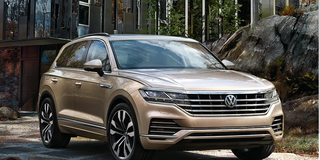Prime
The VW Touareg offers a smooth ride

What you need to know:
In terms of safety, the Touareg has six airbags and front and rear sensors. When driving and there is an object or another vehicle near yours, you will receive an alert to allow you steer to safety. If you are driving at high speed, it will also warn you that you are about to get involved in a crash. It has a sizable trunk where you can carry an average amount of luggage.
When I meet Collins Bareija on a Monday morning in Kiwatule, a Kampala suburb, he is tirelessly checking his home’s perimeter wall, wondering where a vandal could have passed to access his residence. Unfortunately, the side mirror of his 2009 model Volkswagen he has barely owned for a year had been taken during the night.
“I am wondering how I am going to spend between Shs500,000 to Shs1m to buy a new side mirror. If the vandal had just taken the inner mirror, it would have been cheaper than replacing the whole side mirror,” Bareija says.
For long, Bareija had always wanted to change from Japan to German cars because they offer more stability on the road, the reason he acquired the Volkswagen Touareg.
Running on a 3000cc engine, during my test drive of the well raised mid-size luxury sport utility vehicle (SUV), I discovered that in slow Kampala traffic jam, it burns more fuel compared to driving on the highway. For instance, with exactly half a tank, I purposed to drive from Kiwatule to Ntinda via Bukoto, Wandegeya, Entebbe Road at Clock Tower, via Kibuye roundabout to Nateete and eventually to Busega on the Northern Bypass to Naalya and back to Bareija’s home in Kiwatule.
However, when I reached Busega roundabout, I checked the fuel gauge which indicated that one bar of fuel had been consumed. This was because of slow moving traffic as I manoeuvred through traffic congested places such as Kibuye and Ndeeba and Kampala Road. But on the Northern Bypass from Busega to Naalya junction, a distance of approximately 12km, I checked the fuel gauge again and it had moved very few inches off the bar it had consumed when I last checked at Busega.
“When I am to drive to Mbarara in western Uganda, I refuel with Shs400,000 and this fuel will take me from Kampala to my country home in Bushenyi and back to Kampala. It combines speed on a highway with stability at the same time,” Bareija says.

Performance
Much as the Volkswagen Touareg has a four wheel drive (4WD) system, it is not full time. You can engage and disengage it, depending on the road terrain. Like most sport utility vehicles, it has an element of having been customised for African and Ugandan roads. It has an air-matic suspension system that raises the car to a comfortable ground clearance that allowed me to raise it further as I drove through countless potholes as I approached Nateete junction traffic lights.
These potholes stretch all the way to Shell Busega. When driving on a flat road terrain without potholes, it has a provision of lowering the ground clearance, which makes it more stable. When driving in cold weather, it has heated seats that are warmed by a press of a button on the dashboard.
Bareija advises that when you buy a Touareg, the secret to maintaining it without suffering any major mechanical issues is by servicing it on time. Before making any long journey, have it inspected by a trusted mechanic who specialises in German cars.
“When you return from upcountry or any other long journey, have it inspected and the necessary repairs carried out. You also need to have a trusted source for your spare parts. With most German cars, their parts are not repaired but instead replaced. You must also be a good driver. You will not drive into potholes or run over triple or quadruple humps because the car is fit for any road condition. The moment components such as the suspension system is defunct, you will have to replace it. Luckily, I have not replaced any major spare parts apart from the side mirror that was stolen,” Bareija advises.
In the approximately one year he has had the car, Bareija has serviced the Touareg once, which cost him Shs400,000. This he attributes to the fact that the previous owner had maintained the car well. For major service, it depends on what needs to be replaced. However, there are some repairs that cannot have to wait till you cover 5,000km, which is normally the standard mileage at which you do service.
Fuel
For engine longevity and better performance, you have to refuel from trusted fuel stations with high octane fuel that never compromises the car’s performance on and off-road. Depending on the high octane fuel you use, it gives you more mileage compared to ordinary fuel. A full tank costs approximately Shs500,000.
There is a public perception that German cars are expensive to buy and maintain. Bareija instead argues that German cars are cheap to maintain but expensive to repair. For example, when you maintain it well, you will not have to incur high costs on spare parts replacement.




